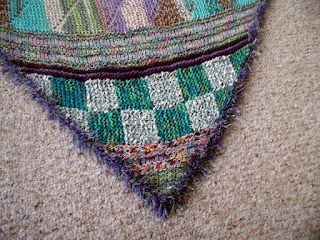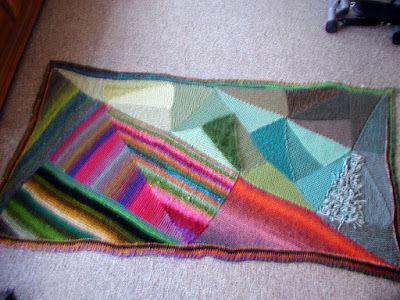Blocking does wonders. And I hate it.
I don't like to sew, which is why I'll go out of my way to knit pieces together instead of joining afterward. I just don't like sewing, even when I don't have to make tiny perfect stitches. I love quilts, love looking at quilt books, but the idea of having to make one, with even seams and equal sizes of pieces, would be torture.
Blocking with blocking wires is a lot like sewing to me, having to thread the wires through the stitches evenly, and then trying to get perfect, albeit stretched, proportions all around. I should think about putting edgings of big loops on
everything, just to make the most hateful part go more quickly.
Here is the latest, being blocked before I add a fuzzy edging.
Yes, I know the bottom point is off -- one of the pins slipped during the night. It looked okay when I unpinned it, thank goodness. I love how blocking brings out the patterns and stitches, and makes the texture more fluid in general. I just hate doing it.
Here's how I block, which is sort of a modified Elizabeth Zimmerman version. I fill the washer with the hottest water on the lowest amount, and add just a tiny amount of detergent or shampoo. I let it agitate, and then add the shawl and let it agitate again until the shawl is completely immersed and swished around a bit (maybe a minute, maybe less), and then pull out the knob to stop the agitation and let it soak for at least 15 minutes. Then I put it on spin. When that's finished, I run the hot again, let it sit to get out any soap, and then spin. If the piece is heavy or otherwise not feeling dry enough, I'll spin it one final time.
Sometimes I can get away with just laying the shawl out at that point, since the hot water has relaxed it enough or I don't want to pull it out of shape. Otherwise, it's the blocking wires to stretch it to within an inch of its life.
The hot water removes any oil or sizing in the yarn, making it softer and helping to even out the stitches. The blocking can get rid of small unevennesses as well as stretch it out to get the full effect, and really does make a difference in the final drape. It's utterly magical with lace in particular, but every shawl I've made has only been improved by the process.
I still hate it.



























